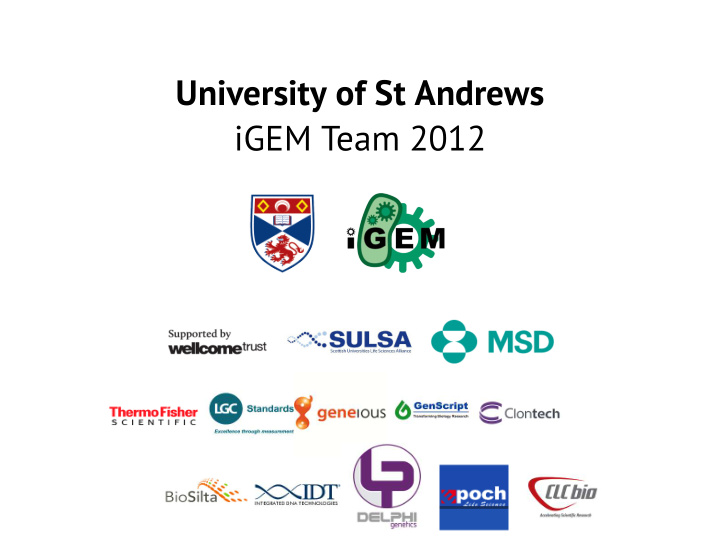



University of St Andrews iGEM Team 2012
1957 1983 2007 “Modern oceans have been so vastly altered by overexploitation of fishes as to be barely recognizable semblances of their pre- exploitation states.” Callum Roberts 2007 The Unnatural History of the Sea All photos taken near Key West, Florida. Left to right: 1 & 2 Monroe County Library collection (Florida Keys) 3. Smithsonian Magazine (September 2008), Loren McClenachan
Fish depletion Our model: “by 2100 only a fraction of today’s fish biomass will remain” - Biodiversity loss - Food problem - Global omega-3 shortage Model predictions for the future if we continue fishing at current rates
ω -3 fatty acid Metal binding synthesis proteins re source Zoe Ashwood Modelling ω -3 fatty Scientific impact acid depletion of iGEM
Modelling fish population dynamics
Real-world fish biomass data - 77 data points - 234 sets of data extrapolated and combined - 1932-2006 time series
Parameter tuning Solid – model’s prediction of biomass; Dots – real-world biomass data Solid – model’s prediction of catch; Dots – real-world catch data
Model’s biomass prediction Model's prediction of world fish biomass (solid), as it changes throughout the years between 1950 and 2100; as well as biomass data (dots).
Alternative aquaculture scheme Omega-3 flow Wild: algae => fish => humans Aquaculture: algae => fish => fish oil => farmed fish => humans Substitute with synthetic omega-3 Fish meal is replaceable with non-fish products. Fish oil contains omega-3: wild fish input required (at present).
Omega-3: required production levels Green: fish-free aquaculture (current output of farmed fish). Purple: fish-free aquaculture (increased output of farmed fish). Blue: world population provided with daily recommended intake of omega-3 of 500mg per day
Model’s biomass prediction (restricted catch) Model predictions for the future if we continue fishing at current rates (dashed) and if we reform our aquaculture habits (orange)
ω -3 fatty acid Metal binding synthesis proteins re source Josi Buerger Modelling ω -3 fatty Scientific impact acid depletion of iGEM
Synthesising the ω -3 pathway 1$ 3$ 7$ 9$ 5$ 3 1$ 18:1$(9)$ 1$ 3$ 7$ 9$ 5$ 3 1$ 18:2$(9,$12)$ 1$ 3$ 5$ 7$ 9$ Figure modified from Livore V., Tripodi K., Utarro A., 2007. Elongation of polyunsaturated fatty acids in trypanosomatids. FEBS Journal, 274: 3 1$ 264–274. 18:3$(9,$12,$15)$
Results Fatty Acid Methyl Ester (FAME) analysis by Gas Chromatography Mass Spectrometry (GC-MS)
Lipid analysis
ω -3 fatty acid Metal binding synthesis proteins re source Josi Buerger Modelling ω -3 fatty Scientific impact acid depletion of iGEM
Short metal binding peptides 6 ¡x ¡His GST New ¡Ni ¡binding ¡ sequence
gBlocks 6 ¡x ¡His GST New ¡Ni ¡binding ¡ sequence 1mbo Precious)) metal) scavenger) Toxic) metal) scavenger)
ω -3 fatty acid Metal binding synthesis proteins re source Antti Korpimaki Modelling ω -3 fatty Scientific impact acid depletion of iGEM
Results summary 200" Teams" 180" Parts"submi6ed"(10s)" 160" Papers"men<oning"iGEM" 140" Papers"men<oning"Parts"Registry" 120" Number'of' Papers"men<oning"specific"Registry"BioBricks" 100" 80" 60" 40" 20" 0" 2004" 2005" 2006" 2007" 2008" 2009" 2010" 2011" Year'
iGEM – Registry relationship
Suggested citation style Team, PartName, PartChassis, Date, [DOI or Link]
re source Conclusions • Successfully modelled past and future fish biomass and our omega-3 requirement • Built part of the omega-3 pathway in E. Coli • Created novel metal binding peptide • Quantified iGEM impact
re source Our sponsors Team St Andrews thanks those who made our project possible Dr Markus Gierth, Adam Boggon, Dr Morven Shearer, Professor Gordon Bell, Jesse H. Ausubel, Jason Fontana, Twitter's Bootstrap, DTU-Denmark 2011 (iGEM team), School of Geography & Geosciences, The Terry K. Smith Laboratory
Recommend
More recommend